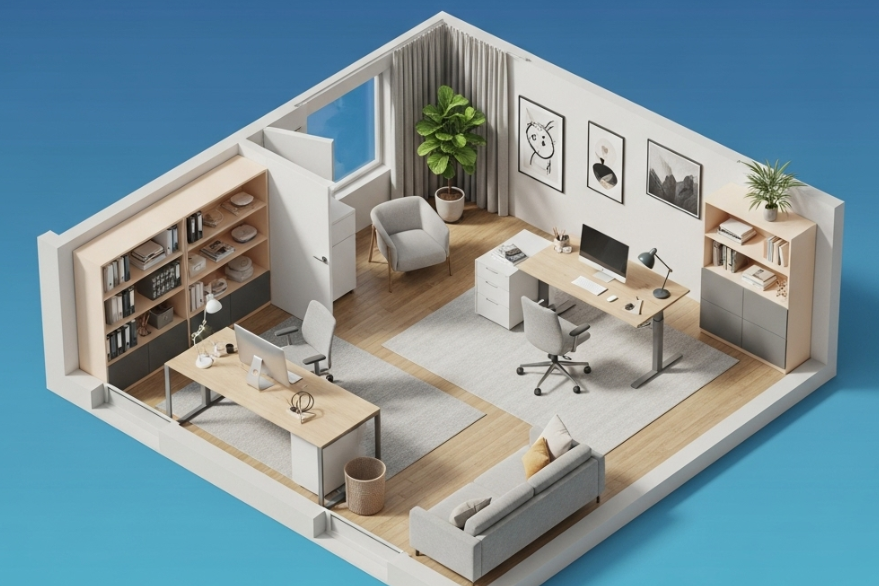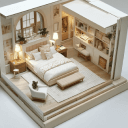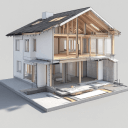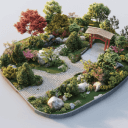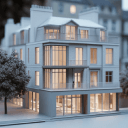Global interior design in 2025 is marked by bold self-expression and sustainable comfort. Designers and homeowners alike are embracing vibrant colors, natural materials, and multi-functional layouts as the new definition of luxury living. A strong shift toward biophilic elements (think natural wood, stone, and plenty of indoor plants) paired with earthy palettes is making homes feel both healthier and more visually striking.
In this article, we’ll explore the top residential design trends across the United States, United Kingdom, and European Union nations – and how you can bring them to life in immersive 3D with modern tools like Arcadium 3D. By the end, you’ll see how anyone (even without formal training) can transform a space with these 2025 trends using intuitive 3D room design technology.
Check Out Our Tool
United States: Personal Comfort, Color, and Character
American living rooms in 2025 are moving beyond bland neutrals. Homeowners are experimenting with rich greens, warm wood tones, and cozy textiles to create a more personal, inviting atmosphere. Natural elements like wooden furniture and plenty of plants bring warmth and biophilic comfort into modern spaces, reflecting the nationwide shift towards earthy palettes and sustainability.
In the U.S., interior design is all about personalization and comfort. Homeowners are shedding the “cookie-cutter” look in favor of bold choices that reflect their personality. For instance, kitchens are moving away from all-white neutrality – it’s now common to see colorful cabinetry, unique hardware, and even art displays in the kitchen, making it a vibrant heart of the home.
The mantra is that no two homes should look the same: individuality is in. This extends to other rooms as well; living spaces mix and match furniture styles and eras, creating an eclectic but homey vibe rather than a perfectly matched set.
One standout U.S. trend for 2025 is the embrace of dramatic lighting and statement fixtures. Instead of relying solely on recessed lights, designers are layering light with sculptural pendants, elegant sconces, and art-like lamps to add character to rooms. A modern chandelier or a geometric floor lamp not only illuminates a space but doubles as a conversation piece. By day, these fixtures are decorative sculptures; by night, they cast warm, layered glows that make a room feel dynamic and cozy.
Another theme across American homes is the use of “moody” colors and richer materials to create a sense of warmth. Where once stark white and cool grays dominated, now you’ll find deep navy home offices, forest green feature walls, and walnut-stained cabinetry.
Designers suggest moving away from pale oak finishes and embracing darker woods like walnut or mahogany for a more luxurious, inviting atmosphere. These richer wood tones, paired with plush fabrics (velvet pillows, chunky knit throws) and warm metals (brass, copper), add depth and a touch of old-world elegance to modern American interiors.
Open-plan layouts are still popular in the U.S., but they’re evolving. Homeowners have realized the need for flexible spaces – a kitchen that flows into a family room is great for gathering, but there’s also a push to carve out “pockets of sanctuary” within open plans. This might mean a cozy reading nook in a corner or a screen that separates a small work-from-home office area.
In 2025, Americans want the best of both worlds: airy communal spaces and intimate corners for privacy. Multifunctional furniture (like extendable tables, storage ottomans, sofa beds) is in high demand, making it easier to adapt rooms for various uses.
Crucially, these U.S. trends are about comfort without sacrificing style. Oversized, sink-in sofas and deep armchairs (often with curved, inviting silhouettes) are key elements of the “casually comfortable” furniture trend sweeping living rooms. The idea is to create relaxed spaces that are as stylish as they are livable.
Even maximalist touches are creeping in – an heirloom rug here, a gallery wall of eclectic art there – to tell a homeowner’s unique story. It’s an organic, collected look that makes a house feel like home. And with the help of technology, Americans are finding it easier than ever to visualize these personalized designs before committing to them in real life (more on that soon).
United Kingdom: Eclectic Tradition Meets Modern Vibrancy
In the UK, interior design trends for 2025 celebrate a harmony of tradition and boldness. British homes are leaning into their rich heritage of pattern and coziness, while also fearlessly using color to liven up spaces. A key phrase among UK designers this year is “the more pattern, color, and mix-matched furniture, the better,” embracing an eclectic, layered look.
This means you’ll walk into a London townhouse and perhaps see a Victorian-style sofa paired with a contemporary coffee table, or a mix of floral and plaid textiles in the same room. Rather than a perfectly matched decor set, the “collected over time” look gives spaces a charming character. It’s reminiscent of classic English country houses where generations of furnishings create a lived-in, storied ambiance.
One of the most distinctive British trends is a move away from anything too matchy-matchy or minimalistic. Designers like Kelly Hoppen note a shift toward embracing asymmetry and surprise in interiors – nothing needs to be overly coordinated. This translates to more creative freedom: an antique brass mirror might hang above an ultra-modern console, or a pair of lamps might deliberately not be identical. The result is a more organic, less “designed” feel that many Brits find inviting and authentic.
Color is king in UK interiors right now. While some years saw Brits favoring greige and cream, 2025 is bringing a full spectrum of hues back into British homes. Designers encourage veering away from bland neutrals – bold paint and upholstery are making statements, from deep peacock-blue kitchen cabinets to ceilings (“the fifth wall”) painted in cheerful coral or dramatic navy.
As Brigitta Freund of Spinocchia Freund says, color is an “essential tool in shaping atmosphere and emotion within a space.” Rather than playing it safe, UK homeowners are splashing personality on their walls. Even wallpaper is having a renaissance, often with whimsical prints or historic patterns. There’s a bit of a rebellion afoot against the once-trendy plain white walls – people are “bored of that overly familiar, plain background,” notes designer Darren Price, and are re-embracing wallpaper and pattern as a result.
Hand in hand with this love of pattern comes the layered look that UK design is known for. A “super layered” room might have an area rug over a larger jute rug, an assortment of throw pillows in various prints, draped throws, and lots of art and books on display. These layers add depth and soul to a room.
An English living room in 2025, for example, might feature toile wallpaper, framed botanical prints, velvet curtains with trimmings, and an assortment of vintage and new furniture – yet it all harmonizes. Lighting is thoughtfully added to this mix as well; multiple lamps and wall sconces create a warm glow that enhances the textures and patterns, giving that signature cozy British ambiance (“hygge” might be Scandinavian, but the Brits have their own version of it in the beloved concept of the “snug”, a small intimate room or corner dedicated to comfort).
Speaking of botanicals, nature-inspired decor continues to thrive in the UK. Classic leafy and floral prints – verdure patterns that have been British staples for centuries – are staying popular on fabrics and wallpapers. Add to that a modern biophilic twist: houseplants galore. From potted ferns in the living room to herb planters in the kitchen, bringing the English garden indoors is very much in style. It connects urban homes to the countryside charm and improves wellbeing by literally adding life to the room.
Whether you’re drawn to the bold maximalism and heritage charm of UK interiors or the personalized comfort of American homes, one thing is clear: 2025’s trends invite creativity. And thanks to technology, you don’t have to imagine how these ideas might look – you can try them out virtually.
In fact, it's never been easier to experiment with a design before you commit. For instance, you can now design a room online free using 3D home design tools to play with a bold British-style wallpaper or an American-style open layout on your screen. This means you can see how that emerald green paint or layered botanical print will actually feel in your space, before you break out the paintbrush or buy new furniture. Such tools empower homeowners everywhere to make informed style choices and fine-tune their decor until it’s just right.
Europe: From Scandinavian Simplicity to Mediterranean Warmth
Across continental Europe, interior design trends in 2025 are as diverse as the cultures within the EU, yet some unifying themes shine through. Broadly speaking, European interiors are balancing a love for clean, modern lines with a rekindled appreciation for history and craftsmanship.
In Northern Europe, the enduring influence of Scandinavian design remains strong – simplicity, functionality, and warmth define many Nordic homes. Styles like Japandi (Japanese + Scandinavian) are still relevant, blending minimalism with cozy touches and natural materials. It’s common in, say, a Copenhagen apartment to see a neutral palette of whites, beiges, and soft grays, accented by light wood floors and furniture.
The twist in 2025 is adding a cozy twist to that minimalism: a sheepskin throw here, a cluster of candles there, to ensure the space doesn’t feel cold. This “warm minimalism” trend is evident across Europe’s design fairs – even ultramodern furniture is being paired with textured rugs or ambient lighting to make minimalist spaces more inviting.
Moving south, Mediterranean influences are making waves throughout Europe. One standout is the resurgence of terracotta – not just as floor tiles but even as a wall color and overall palette. In sunny Spain and Italy, terracotta-toned plaster walls and clay tiles have always been classic; now this warm, earthy hue is spreading to homes in cooler climates too.
Designers across Europe predict rich terracotta and adobe hues will be among the “colors of the year,” offering a bolder alternative to plain neutrals. A Parisian or Berlin living room might incorporate a feature wall in a burnt sienna or rusty clay shade, instantly infusing the space with Mediterranean warmth and depth. Terracotta’s appeal lies in its ability to straddle the line between a neutral and a statement color – it’s grounding and calming while still full of character.
European designers are also looking backwards to move forwards. There’s a notable revival of vintage and retro pieces in contemporary European decor, much like in the U.S. and UK. Mid-century modern furniture, 1970s-inspired color schemes, and Art Deco accents are being reinterpreted in fresh ways.
This trend is about blending old and new – a modern Barcelona loft might feature a 1960s credenza or a set of Thonet bistro chairs for a touch of nostalgia. These retro influences add history and personality to otherwise sleek interiors. As one design editor noted, vintage furniture and nostalgic decor items can “infuse contemporary homes with a sense of history and personality,” especially when given a modern twist in how they’re combined.
Europe’s rich design heritage (from French antiques to Bauhaus modernism) provides a vast treasure trove to draw from, and 2025 is seeing homeowners across EU nations mix heirlooms or flea-market finds alongside new buys to create truly unique spaces.
Hand in hand with vintage love is a growing appreciation for artisanal and handcrafted decor. In an era dominated by global retail, Europeans are increasingly valuing the local craft – be it a handwoven Belgian rug, a set of Portuguese ceramic tiles, or a custom hand-blown glass light from Murano. These pieces bring one-of-a-kind character and support heritage skills.
Plus, they align with the sustainability ethos by favoring quality and longevity over disposable decor. From handmade tiles to bespoke woodwork, artisanal touches are elevating European interiors, adding what mass-produced items can’t: a human touch and story. Supporting local artisans is seen not just as a style choice but a statement of cultural pride and eco-consciousness.
For example, in a trendy Stockholm flat you might find a contemporary sofa paired with a hand-loomed Finnish tapestry on the wall, or a sleek Dutch kitchen outfitted with handcrafted Spanish terracotta pendants above the island. This mix of modern and crafted keeps spaces from feeling too impersonal or catalog-like.
Color trends across Europe mirror the global move to richer, more saturated tones. After a long love affair with all-white minimalist interiors (especially in the 2010s), many European designers are welcoming back color in thoughtful ways. Jewel tones and deep earthy colors are popping up from Lisbon to Ljubljana.
You’ll see elegant emerald green velvets in Milan apartments or warm mustard and ochre upholstery in a chic Stockholm office. In fact, interior experts say that a bold, earthy palette can pair beautifully with Europe’s modern multifunctional spaces, bringing both comfort and visual impact. Don’t think it’s all maximalism, though – Europeans are masters of moderation. Often a mostly neutral room will get a shot of drama from one richly colored accent wall or a set of vibrant drapes, achieving that balance between calm and character.
Layouts in European homes are also adapting to new needs. The “rise of the hybrid room” is a trend noted in design circles – much like elsewhere, people are asking their spaces to do more. In smaller urban apartments, one room might serve as living area by day and bedroom by night (hence the popularity of high-quality sofa beds and inventive partition solutions).
In larger homes, a formal dining room might double as a remote-work office when not in use, or a guest room might also function as a gym/yoga space. European designers are known for clever solutions to maximize space, from Italian transformable furniture to German ergonomic home-office nooks that tuck away.
In 2025, this ingenuity is in full swing, making homes more flexible without sacrificing style. For example, you might find a bookshelf that converts into a desk in a student flat in Paris, or an ottoman that hides office supplies in a family home in Amsterdam – all in service of harmoniously blending work, play, and relaxation in one place.
Finally, across Europe we see a continued love for clean lines and quality materials – a legacy of modernist design that remains. While curves and funky shapes had a big moment in recent years, there’s a gentle swing back to timeless, simplified forms in furniture and fixtures. This doesn’t mean boring; it means a well-crafted oak dining table with simple lines or a chrome arc floor lamp that still looks futuristic.
In fact, metallic finishes are an interesting split: some designers champion warm metals like brass and copper for their cozy glow (especially in lighting or kitchen hardware), while others are reviving cool metals like chrome and stainless steel for a sleek, retro-modern look. Don’t be surprised if you see mixed metals in the same room – that’s part of the eclectic charm of 2025. A brushed brass faucet can coexist with a matte black cabinet handle and a chrome light fixture if done thoughtfully, adding layers of interest.
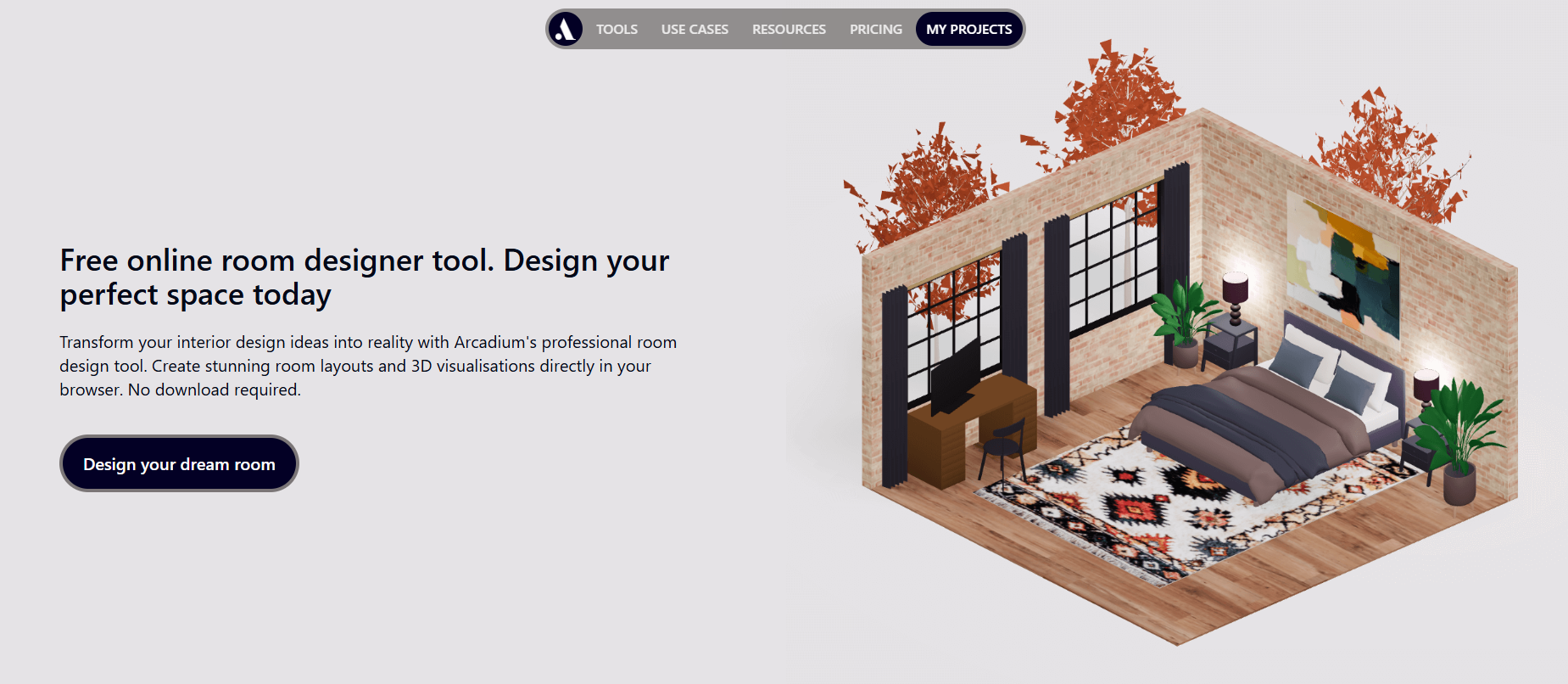
Bringing Trends to Life in 3D with Arcadium 3D
Arcadium 3D’s intuitive interface lets you experiment with layouts, colors, and decor in a realistic virtual model of your room. For example, as shown above, you can visualize a cozy living room design on a tablet before making any physical changes. The ability to “try on” different wall colors, furniture arrangements, and lighting in 3D helps ensure your 2025 design ideas look just as good in reality as they do in your imagination.
All these exciting trends can feel inspiring yet overwhelming – you might wonder how to practically apply them in your own home. This is where Arcadium 3D truly shines. As a cutting-edge, browser-based design tool, Arcadium 3D allows anyone to become a room designer and bring their ideas to life in a virtual space.
You don’t need to be an architect or interior designer to use it; the platform is built to be user-friendly and approachable. In fact, Arcadium is a fast and easy 3D house design tool that runs online (no complex software installation required) and comes loaded with features like a built-in furniture library, precise measurements, and even instant rendering of your designs.
What does that mean for you? It means you can recreate your room in 3D – mapping out the exact dimensions of your space – and then start experimenting with all the 2025 trends virtually. Curious how a pattern-drenched UK-style wallpaper might look in your foyer? With Arcadium, you can apply a wallpaper texture to the walls in a few clicks.
Want to test a bold U.S.-inspired kitchen color scheme? Swap out cabinet finishes and wall paints in the 3D model to see if a sunny yellow or deep navy suits your taste. Considering a Scandinavian minimalist layout for your living room? You can drag and drop furniture pieces from Arcadium’s extensive library (which includes modern and classic styles) to plan the perfect configuration. The ability to quickly try different color palettes, layouts, and materials – without buying a single gallon of paint or moving heavy furniture – is liberating and fun.
Arcadium 3D also integrates advanced visualization tools. Once you have your 3D room sketched out, you can switch to an immersive view to take a virtual walkthrough. This is fantastic for getting a sense of the ambiance: you can experience how the layered lighting design feels at eye level, or whether that open-plan kitchen flows nicely into the living area.
The platform even has an AI-powered interior design feature that can generate high-quality renderings or apply different decor styles to your 3D layout automatically, giving you a realistic preview of your transformed space. In other words, you’re not just looking at a crude floor plan – you’re virtually stepping into your future “after” photo.
Another advantage is how collaborative and iterative the design process becomes with a tool like Arcadium. You can save multiple versions of your room design – maybe one version where you’ve gone maximalist with pattern mixing and jewel tones, and another where you’ve kept a minimalist earthy-neutral vibe – and compare them.
If you have family or a design-savvy friend, you can share your 3D design (Arcadium lets you share a project via a simple URL) and get feedback. It’s much easier for someone to understand your vision when they can pan around a 3D model of your actual room than when you try to describe it in words. For professionals and DIY designers alike, this accelerates the feedback loop and leads to more refined results.
Ultimately, the combination of 2025’s inspiring design trends and Arcadium 3D’s powerful visualization capabilities means that anyone can achieve a transformation in their home. The trends from the U.S., UK, and EU offer a rich palette of ideas – from cozy layered textiles and bold colors to sleek sustainable materials and time-honored decor pieces.
Arcadium gives you the virtual canvas to mix and match these ideas fearlessly. Before you know it, you’ll have designed a space that not only looks on-trend and beautiful, but also feels uniquely you. And because you brought it to life in 3D first, you can approach the real-world implementation with confidence, having already “lived” in your new design digitally.
In conclusion, 2025’s global interior design trends invite you to be creative, whether you’re drawn to American-style comfort, British eclectic charm, or European chic. With Arcadium 3D by your side, you’re empowered to design, visualize, and refine your dream room online – truly bringing these trends to life in 3D before your eyes. So go ahead, dive into that design adventure: your future favorite room is just a few clicks away from becoming a (virtual) reality, and then a real one.
Check Out Our Tool


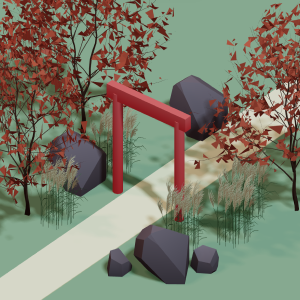 All training, tips and articles
All training, tips and articles
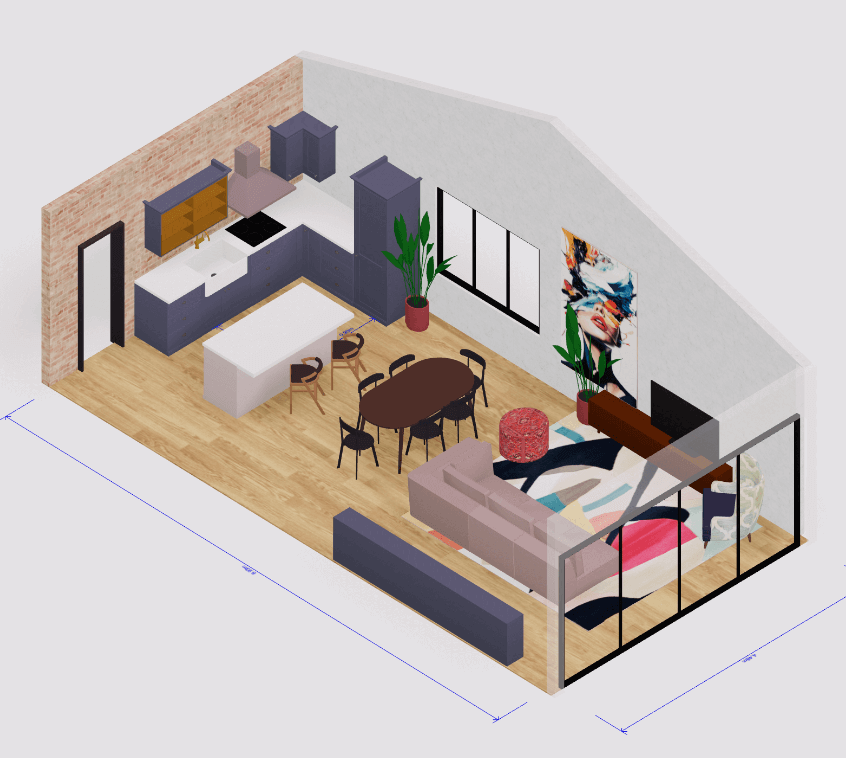 3D house design tool
3D house design tool
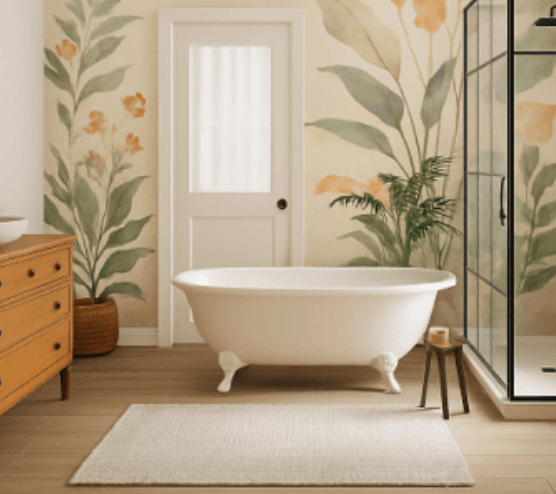
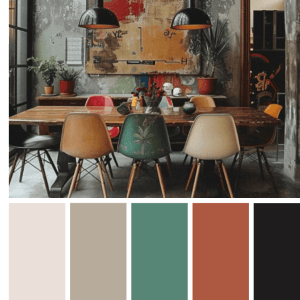 Color palette generator
Color palette generator
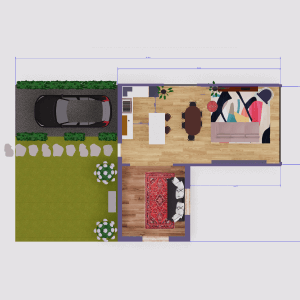 Floor plan creator
Floor plan creator
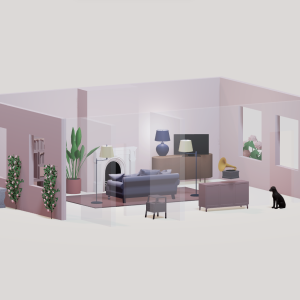 Interior design app
Interior design app
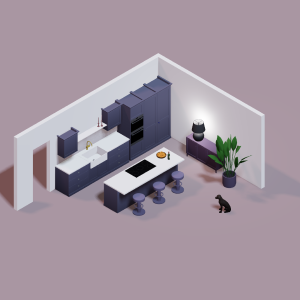 Kitchen design tool
Kitchen design tool
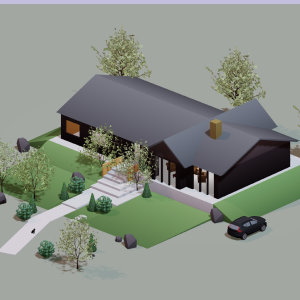 House design software
House design software
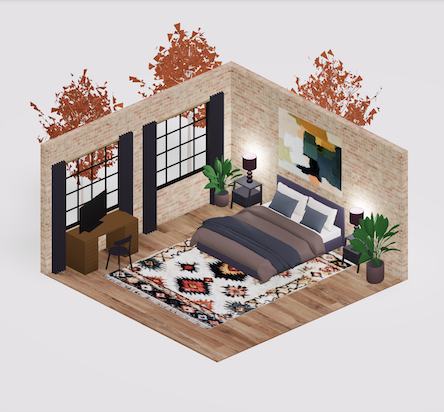 Room designer
Room designer
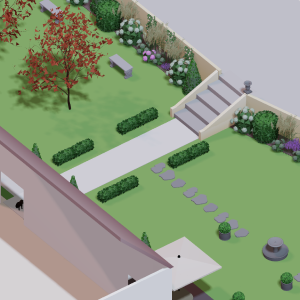 Landscape design software
Landscape design software
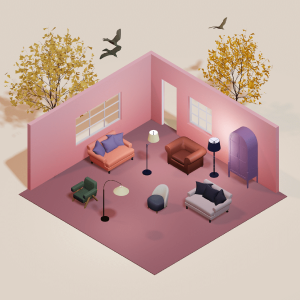 Bedroom design
Bedroom design
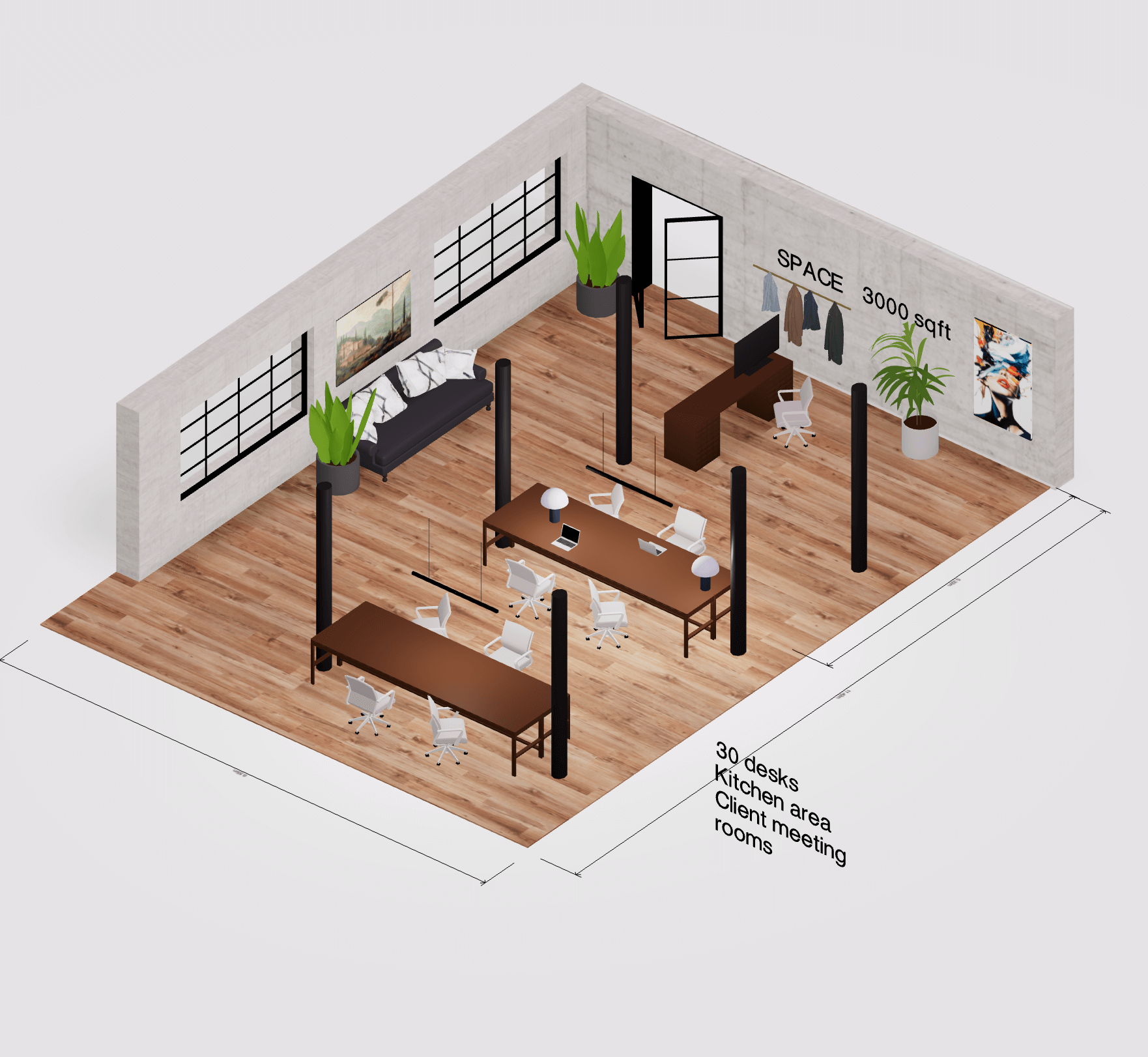 Office floor plan creator
Office floor plan creator
